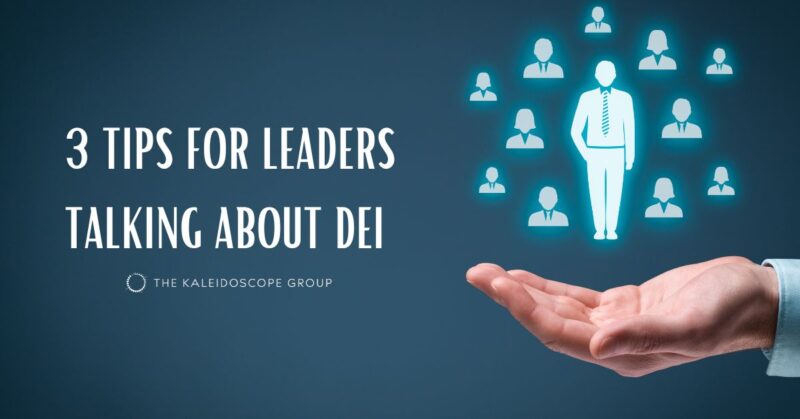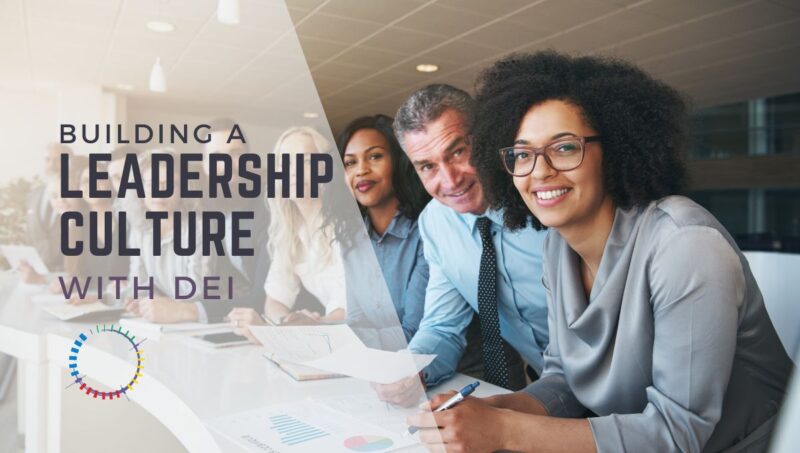Why Diversity, Equity and Inclusion Drives Better Innovation
May 15, 2024

Organizations across the globe are working to innovate for a competitive advantage. Getting to the top of the industry through innovation doesn’t mean your company will always remain in that position. Even large companies face challenger brands and challenging times. Disruption in business is happening and organizations need to know how to build and maintain the most ideal environment for innovation to harness the power of Diversity, Equity, and Inclusion (DEI) to drive innovation and growth. While many companies recognize the importance of DEI, they often struggle to connect these initiatives to tangible business outcomes.
The truth is that DEI practices, when done well, contribute to company success and revenue growth.
Building on the foundation of DEI initiatives, organizations can create a fertile ground for innovation that yields measurable business results. When diverse perspectives are not only present but actively valued and integrated into decision-making processes, companies tap into a wellspring of creativity and problem-solving capabilities. Diversity of thought challenges conventional wisdom, encourages out-of-the-box thinking, and leads to more robust solutions. Equity ensures that all team members have the resources and opportunities to contribute their unique insights, while inclusion fosters an environment where individuals feel safe to voice unconventional ideas. This synergy of diverse minds, equitable support, and inclusive practices accelerates the innovation cycle, enabling companies to identify market gaps, develop groundbreaking products, and refine existing offerings with greater agility.
Research shows that organizations with strong DEI practices often find themselves better equipped to understand and serve diverse customer bases, leading to expanded market reach and increased customer loyalty. By cultivating a workforce that reflects the global marketplace, businesses can anticipate trends, address unmet needs, and create solutions that resonate across various demographics. Ultimately, the correlation between effective DEI practices and innovation becomes clear: companies that embrace diversity, foster equity, and champion inclusion are more likely to outperform their competitors, adapt to market changes, and sustain long-term growth in an increasingly complex business landscape.
The Difference Between Invention and Innovation
To fully grasp the impact of DEI on business outcomes, it’s crucial to understand the distinction between invention and innovation. Invention is the creation of a new product, process, or technology—it’s about bringing something entirely new into existence. Innovation, on the other hand, is about improving upon existing ideas, products, or processes to create value. It’s the practical application of creativity that leads to meaningful change and improvement in business operations, customer experiences, or market offerings.
Innovation doesn’t always require a groundbreaking invention. Often, it involves finding new ways to use existing technologies, reimagining processes, or combining ideas from different fields to solve problems more effectively. This is where the power of diverse perspectives becomes invaluable. When teams bring together individuals with varied backgrounds, experiences, and ways of thinking, they’re more likely to approach challenges from multiple angles, leading to more comprehensive and innovative solutions.
For instance, innovation might manifest as:
![]()
Streamlining a manufacturing process to reduce waste and increase efficiency
![]()
Adapting a product to meet the needs of an underserved market segment
![]()
Developing a new business model that disrupts traditional industry practices
![]()
Implementing a novel approach to customer service that enhances user experience
Understanding Innovation in the Context of DEI
At its core, innovation is about creativity and approaching problems from new angles. Kasia Ganko-Rodriguez, leading DEI consultant with The Kaleidoscope Group points out, “Thoughts spark more thoughts. When we bring together people with diverse perspectives and experiences, we create a fertile ground for innovation. This diversity of thought allows teams to see challenges from multiple angles, leading to more creative problem-solving.”

By fostering a culture of DEI, organizations create an environment where team members feel empowered to question the status quo, share unconventional ideas, and collaborate across boundaries. Very often people have the answer on what needs to be done. But they don’t necessarily have the voice, or they aren’t invited to the right meeting where they could share it. By prioritizing DEI, we can ensure that all voices are heard, unlocking the full innovative potential of our organizations.
Empowerment Releases Innovation
The synergy between Diversity, Equity, and Inclusion (DEI) and innovation is catalyzed by empowerment, which acts as a powerful accelerant in the creative process. This empowerment manifests in multifaceted ways, transforming both individual mindsets and organizational structures. Consider all of these ways a thriving team can contribute to an empowered culture:
- Individual Empowerment
In an inclusive environment, employees feel free to leverage their unique perspectives, cultural insights, and cognitive styles. This freedom fosters authenticity, encourages calculated risk-taking, and promotes a sense of ownership over ideas. When individuals feel valued for their diverse contributions, they’re more likely to engage in innovative thinking, challenge existing norms, and actively participate in problem-solving processes. This self-empowerment creates a ripple effect, inspiring peers and contributing to a culture of continuous innovation and improvement.
- Cultural Reinforcement
Organizational empowerment is embedded in the company’s DNA. For good or for ill, the sum total of the policies, practices, and leadership behaviors set the standard for what will be reinforced culturally. Great DEI initiatives include actively soliciting and value diverse viewpoints. That can be stated and even integrated into written policies. But over time, companies can make a significant cultural commitment goes beyond superficial acknowledgment of diverse thinking. Instead, varied contributions are integrated into core decision-making processes and strategic planning. This commitment has a positive impact on increased innovation.
- Psychological Safety
A cornerstone of empowerment, psychological safety allows team members to take calculated risks without fear of retribution or ridicule. In environments where diverse voices are truly valued, individuals are more likely to propose unconventional ideas or challenge existing paradigms, knowing their input will be received constructively.
- Cross-functional Collaboration
Empowerment in a DEI-focused organization breaks down silos between departments and hierarchies. This cross-pollination of ideas from various disciplines and levels of experience can lead to unexpected innovations that might not emerge in more rigid structures. Ideas beget ideas and often, what seems obvious in one line of work is an undiscovered approach to a challenge in another department. Connecting with co-workers with different skills, perspectives, approaches, disciplines, etc. is a great way to encourage innovative thinking.
- Resource Allocation
True empowerment involves providing equitable access to resources—time, budget, tools, and mentorship—across all demographics. This ensures that innovative potential is not stifled due to lack of support or opportunity. When the same groups of people have access to limited resources, or any resources they tend to use them in the same way. Considering a shake up in resource allocation, or at least letting resource allocation be flexible can signal to a team that great ideas are rewarded no matter where they come from.
- Decision-making Authority
Empowerment extends to granting appropriate levels of autonomy in decision-making processes. When diverse team members are trusted to make decisions within their realm of expertise, it speeds up the innovation cycle and fosters a sense of ownership.
- Feedback Loops
Empowered organizations create robust feedback mechanisms that ensure all voices are heard and considered. This iterative process of idea sharing, feedback, and refinement is crucial for nurturing innovations from concept to implementation.
- Recognition and Reward Systems
Empowerment is reinforced through equitable recognition practices that celebrate diverse contributions to innovation. This goes beyond traditional metrics to acknowledge the value of different types of input and impact.
- Continuous Learning Culture
An empowering environment encourages lifelong learning and skill development across all levels. This commitment to growth enables team members to stay at the forefront of their fields and bring fresh perspectives to innovation challenges.
- Inclusive Leadership
Leaders in empowering organizations model inclusive behaviors, actively seeking out diverse viewpoints and demonstrating vulnerability by admitting when they don’t have all the answers. This approach cultivates an environment where innovation can flourish at all levels.
By fostering these elements of empowerment, organizations create a fertile ecosystem for innovation. In this environment, the collective intelligence of a diverse workforce is unleashed, leading to more creative problem-solving, enhanced adaptability to market changes, and the development of products and services that resonate with a broader customer base.
Empowerment in the context of DEI doesn’t just benefit the organization internally. It also positions the company as a thought leader and innovator in its industry, attracting top talent from diverse backgrounds and fostering partnerships with a wider range of stakeholders. This external perception can open doors to new markets, collaborations, and opportunities for growth that might otherwise remain inaccessible.
Ultimately, the confluence of empowerment and DEI practices in action creates a self-reinforcing cycle of innovation. As diverse teams feel more empowered, they innovate more effectively. These successes, in turn, reinforce the value of DEI practices, leading to greater empowerment and an even stronger commitment to inclusivity. This virtuous cycle propels organizations forward, enabling them to stay ahead in an increasingly competitive and rapidly evolving global marketplace.
The Three Pillars of DEI-Driven Innovation
To truly harness the power of DEI for innovation, organizations need to focus on three key areas: Beliefs, Behaviors, and Practices. These pillars form the foundation of a culture that not only embraces diversity but actively leverages it for innovative outcomes.
- Beliefs
Organizations must internalize the conviction that diversity is critical for innovation to flourish. This involves recognizing the inherent value of diverse voices and perspectives, understanding that our unique experiences shape our thinking and problem-solving approaches and acknowledging that certain beliefs enable innovation while others can hinder it. By cultivating these beliefs, companies lay the groundwork for a mindset that naturally seeks out and appreciates diverse inputs in the innovation process. - Behaviors
Beliefs must be translated into tangible behaviors that support innovation. This transformation begins with suspending preconceived notions, allowing individuals to remain open to new ideas and possibilities. It involves creating space for thoughtful consideration rather than always defaulting to a task-oriented “to-do” mode, giving innovative ideas room to breathe and develop. Furthermore, it requires actively seeking out and affirming contrarian views to challenge conventional thinking, pushing the boundaries of what’s possible. This requires developing a keen awareness of other people’s lenses and viewpoints, recognizing that each individual’s unique perspective can contribute valuable insights to the innovation process. By embodying these behaviors, organizations can create an environment where diverse thoughts are not just tolerated but actively encouraged and explored, paving the way for breakthrough innovations. - Practices
To ensure that beliefs and behaviors lead to concrete results, specific practices must be implemented. This involves restructuring meetings to encourage diverse input, such as consistently asking, “Does anyone see this differently?” Organizations should also reward “mistakes” made in pursuit of innovation, helping people unlearn the fear of failure and recognizing that great innovation often requires multiple iterations. It’s crucial to implement processes that challenge groupthink and cognitive biases, acknowledging our tendency to gravitate toward quick, easy, and familiar solutions. These practices institutionalize the commitment to DEI-driven innovation, making it a consistent part of organizational operations rather than a sporadic effort. By embedding these practices into the fabric of daily work, companies create an environment where diversity of thought is not just encouraged but becomes a fundamental driver of innovation and problem-solving.
By aligning beliefs, behaviors, and practices, organizations create a cohesive approach to DEI that drives innovation. This integrated strategy ensures that diversity is not just a buzzword but a powerful tool for creative problem-solving and business growth. It transforms the simple act of bringing diverse people to the table into a dynamic process of leveraging varied perspectives for breakthrough innovations.
The Link Between DEI and Employee Engagement
Employees who feel valued and included are more likely to be engaged and contribute their best ideas. This engagement is crucial for innovation, as it creates an environment where people feel safe to voice new thoughts and challenge the status quo. Innovation goes hand in hand with problem solving andreat problem solving requires deep engagement. One way companies address this connection is through establishing employee resource groups best practices. Successful ERGS initiatives can create a strong link between diversity, equity and inclusion training and measurable improvement of employee satisfaction.
Risks of Neglecting DEI in the Workplace
Failing to prioritize DEI can lead to missed opportunities for innovation. When companies don’t tap into the diverse perspectives of their workforce, they risk:
– Overlooking potential problems or solutions
– Failing to connect with diverse market segments
– Losing talented employees who don’t feel valued or heard
Integrating DEI into Organizational Growth
Companies need to integrate these principles into their core processes to benefit from DEI-driven innovation, but enjoy other benefits of employee retention while meeting professional growth and development objectives. When mindful about integrating DEI into organization growth some issues to review include:
– Reevaluating HR strategy around hiring and promotion practices
– Creating forums for diverse voices to be heard
– Training leaders to recognize and value diverse perspectives
– Investing in customizable professional development
The Approach
At The Kaleidoscope Group, we don’t just talk about DEI—we help organizations implement practical strategies that drive real business outcomes. When making a case for change, the best business case is one that is measurable and leads to both short-term and long-term business impact. Our approach focuses on creating sustainable change by simultaneously addressing beliefs, behaviors, and practices.
Innovation is more crucial than ever in today’s business landscape. Often a competitive advantage emerges from diverse thinking, and a culture of openness that allows many voices to be heard. This kind of environment is one where people begin to feel free to make mistakes, share interesting ideas and trailblaze. By embracing Diversity, Equity, and Inclusion, companies can create an environment where innovative ideas flourish, leading to better problem-solving, improved products and services, and ultimately, stronger business results.


